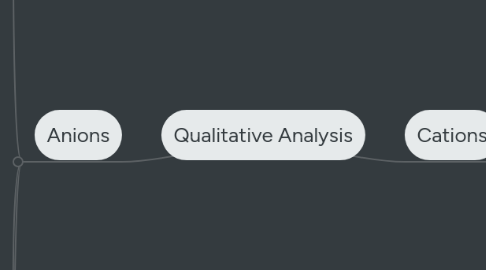
1. Anions
1.1. Dilute H₂SO₄ Test
1.1.1. Identification
1.1.1.1. NO gas
1.1.1.1.1. Turns FeSO solution black
1.1.1.1.2. Reddish brown
1.1.1.1.3. Indicates NO .
1.1.1.2. H S gas
1.1.1.2.1. Smells like rotten eggs
1.1.1.2.2. Turns lead acetate paper black
1.1.1.2.3. Indicates S .
1.1.1.3. SO gas
1.1.1.3.1. Turns acidified potassium dichromate paper green.
1.1.1.3.2. Indicates SO .
1.1.1.4. CO gas
1.1.1.4.1. Turns lime water milky.
1.1.1.4.2. Indicates CO .
1.1.2. Confirmation
1.1.2.1. CO
1.1.2.1.1. Add MgSO solution
1.1.2.2. S
1.1.2.2.1. Acetic Acid+Lead Acetate
1.1.2.2.2. Sodium nitroprusside solution
1.1.2.2.3. Suspension of CdCO
1.1.2.3. SO
1.1.2.3.1. BaCl solution
1.1.2.3.2. Acidified KMnO .
1.1.2.4. NO
1.1.2.4.1. Acetic Acid+FeSO4
1.1.2.4.2. 2-3 drops H₂SO₄ +KI solution +Starch solution
1.1.2.4.3. Few drops acidified KMnO .
1.2. Conc. H₂SO₄ Test
1.2.1. Identification
1.2.1.1. HCl gas
1.2.1.1.1. White ppt
1.2.1.1.2. Cl indicated
1.2.1.2. Br gas
1.2.1.2.1. Turns starch paper yellow or orange
1.2.1.2.2. Br indicated
1.2.1.3. I gas
1.2.1.3.1. Turns starch paper blue
1.2.1.3.2. I indicated.
1.2.1.4. NO gas
1.2.1.4.1. Turns FeSO solution black
1.2.1.4.2. NO indicated
1.2.1.5. CO gas
1.2.1.5.1. A colorless, odourless gas
1.2.1.5.2. C O indicated
1.2.1.6. Vinegar smell
1.2.1.6.1. CH COO indicated
1.2.2. Confirmation
1.2.2.1. Cl
1.2.2.1.1. Add conc. HNO and AgNO
1.2.2.1.2. MnO + conc. H₂SO₄ + heat
1.2.2.1.3. K Cr O + conc. H₂SO₄ +heat
1.2.2.2. Br
1.2.2.2.1. Conc. HNO + AgNO solution
1.2.2.2.2. Dil. HCl+1-2ml carbon disulphide+chlorine water +shake
1.2.2.3. I
1.2.2.3.1. Conc. HNO + AgNO solution
1.2.2.3.2. Dil. HCl+1-2ml carbon disulphide+chlorine water +shake
1.2.2.4. CH COO
1.2.2.4.1. Oxalic acid+2-3 drops of water
1.2.2.4.2. Conc. H₂SO₄ +Ethyl alcohol+heat
1.2.2.5. C O
1.2.2.5.1. Acetic Acid+CaCl solution
1.2.2.5.2. Dil. H₂SO₄ (warm) +2-3 drops KMnO solution
1.2.2.6. NO
1.2.2.6.1. Conc. H₂SO₄ +Cu chips+Heat
1.2.2.6.2. FeSO solution+ Conc. H₂SO₄
1.3. No Reaction
1.3.1. SO
1.3.1.1. Dil. HCl + BaCl solution
1.3.1.1.1. White ppt.
1.3.2. PO
1.3.2.1. Conc. HNO +boil
1.3.2.1.1. Add amm. molybdate and heat
1.3.2.2. Magnesia mixture
1.3.2.2.1. White ppt
2. Cations
2.1. To find the group
2.1.1. Test for NH .
2.1.2. Add dil. HCl to OS
2.1.2.1. White ppt.
2.1.2.1.1. Group 1 (Pb )
2.1.3. Pass H S gas after acidification with dil HCl
2.1.3.1. Black ppt
2.1.3.1.1. Pb ,Cu .
2.1.3.2. Yellow ppt
2.1.3.2.1. As
2.1.4. Add solid NH Cl,0.5 ml conc. HNO to the OS. Add NH OH.
2.1.4.1. Reddish brown ppt.
2.1.4.1.1. Fe
2.1.4.2. White ppt.
2.1.4.2.1. Al
2.1.5. Through above sol, pass H S gas.
2.1.5.1. White ppt
2.1.5.1.1. Zn
2.1.5.2. Black ppt
2.1.5.2.1. Ni and Co
2.1.5.3. Flesh colored
2.1.5.3.1. Mn
2.1.6. To OS, add solid NH Cl+NH OH+(NH ) CO
2.1.6.1. White ppt
2.1.6.1.1. Ba , Sr , Ca
2.1.7. If group 5 is absent test for Mg.
2.2. Group 1
2.2.1. Pb
2.2.1.1. Boil with distilled water and divide into two parts
2.2.1.1.1. Add KI
2.2.1.1.2. Add K Cr O
2.3. Group 2
2.3.1. Cu
2.3.1.1. Add excess of NH OH
2.3.1.1.1. Deep blue solution
2.3.1.2. Acidify deep blue solution with dil. acetic acid. Add potassium ferrocyanide
2.3.1.2.1. Chocolate brown ppt
2.3.2. Pb
2.3.2.1. Add KI
2.3.2.1.1. Yellow ppt
2.3.2.2. Add K Cr O
2.3.2.2.1. Yellow ppt
2.3.3. As
2.3.3.1. Conc. HNO + Ammonium molybdate
2.3.3.1.1. Yellow ppt.
2.3.3.2. Magnesia mixture
2.3.3.2.1. White ppt
2.4. Group 3
2.4.1. Fe
2.4.1.1. Dissolve in dil HCl and divide into two parts
2.4.1.1.1. Potassium ferrocyanide
2.4.1.1.2. Pot. Sulphocyanide
2.4.2. Al
2.4.2.1. Charcoal cavity-cobalt nitrate test
2.4.2.1.1. Blue mass
2.4.2.2. Dil HCl+Few drops blue litmus sol+NH OH in excess
2.4.2.2.1. Blue ppt
2.5. Group 4
2.5.1. Zn
2.5.1.1. Dissolve in dil HCl and divide into two parts
2.5.1.1.1. Potassium ferrocyanide
2.5.1.1.2. NaOH
2.5.2. Ni /Co
2.5.2.1. Note colour
2.5.2.1.1. Greenish
2.5.2.1.2. Purple
2.5.3. Co
2.5.3.1. NH OH+pinch of Potassium nitrite+dil Acetic acid
2.5.3.1.1. Yellow ppt
2.5.3.2. Boraxbead test
2.5.3.2.1. Blue bead
2.5.4. Ni
2.5.4.1. NH OH+ Dimethyl glyoxime
2.5.4.1.1. Bright red ppt
2.5.4.2. Borax bead test
2.5.4.2.1. Brown in oxidising flame
2.5.4.2.2. Grey in reducing flame
2.5.5. Mn
2.5.5.1. Dil HCl+ boil of H S, add NaOH And bromine water
2.5.5.1.1. White ppt turning grey
2.5.5.2. Borax bead test
2.5.5.2.1. Pink in oxidising flame
2.5.5.2.2. Colorless in reducing flame
2.6. Group 5
2.6.1. Ba
2.6.1.1. K CrO solution
2.6.1.1.1. Yellow ppt
2.6.1.2. Light green flame
2.6.2. Sr
2.6.2.1. Ammonium sulphate
2.6.2.1.1. White ppt
2.6.2.2. Crimson red fame
2.6.3. Ca
2.6.3.1. Ammonium oxalate
2.6.3.1.1. White ppt
2.6.3.2. Brick red flame
2.7. Group 6
2.7.1. NH
2.7.1.1. Conc NaOH
2.7.1.1.1. Ammonia gas evolves
2.7.2. Mg
2.7.2.1. NH Cl+NH OH+Ammmonium phosphate solution
2.7.2.1.1. White ppt
2.7.2.2. Charcoal cavity- cobalt nitrate test with white ppt
2.7.2.2.1. Pink mass

